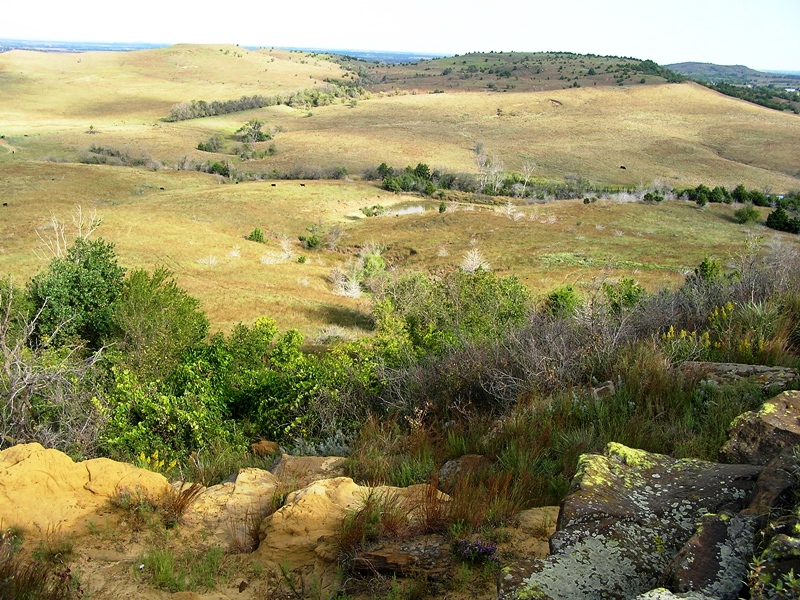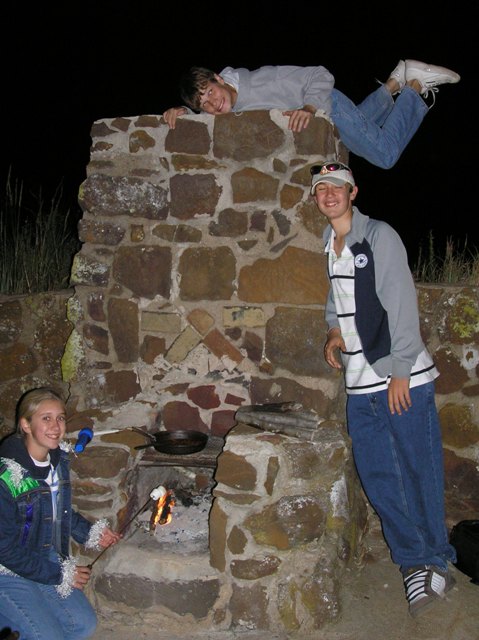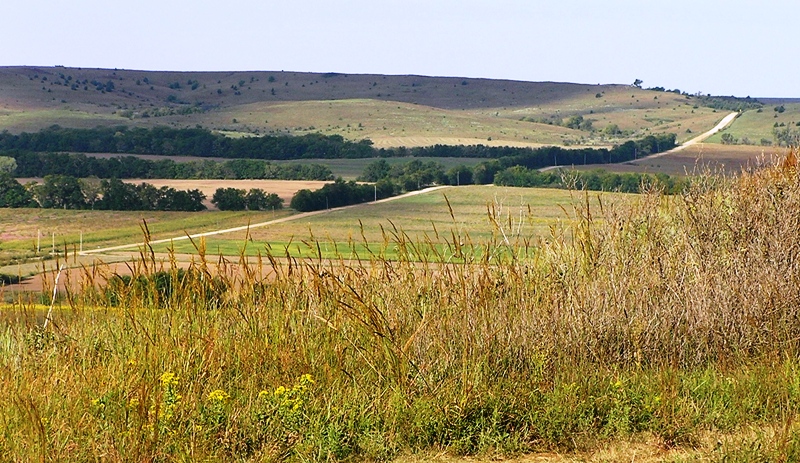Coronado Heights is one of the 8 Wonders of Kansas Geography because...it is an inspiring historic landmark and natural platform of
Dakota Formation sandstone from which to observe the Smoky Hills and Smoky Hill River valley below.Location: Three miles north and one mile west of Lindsborg on blacktop
west side of town, then west on Coronado Heights Road past the
cemetery, then north.
The park is open dawn to 10 p.m.
The following was written by Ruth Peterson. Ruth grew up a half mile from Coronado Heights.

|
Photo courtesy Jim Turner
|
The Story
To begin the story of Coronado Heights, let's reach back to 1541. In
this year, Spanish explorer Francisco Vasquez de Coronado is believed
to have explored the central Kansas area. Based in Mexico, Coronado
and his party journeyed northward in search of the vaunted cities of
gold. Some historians believe Coronado and his men journeyed as far
north as current day Lindsborg and may have used the current day hill,
called Coronado Heights, as a lookout or encampment.
When he arrived, Coronado found peaceful Indian tribes, and he wrote to
the King of Spain about the land's bounty and beauty. But Coronado
found no fabulous wealth. Still, researchers try to document the
northward extent of Coronado's travels. Artifacts including wood crafts
and Spanish coins were reported found by Swedish settlers in the area,
and a small piece of woven metal believed to be chain mail was
documented by a Bethany College professor. All these reports fueled
beliefs that Coronado found his way to the area. While Coronado's
search for gold was unsuccessful, the hill eventually was named for
this bold explorer.
When looking at Coronado Heights from afar, it is easy to see why
peoples over the centuries considered Coronado Heights both monument
and gathering place. Surrounded by gently rolling plains, Coronado
Heights juts 300 feet above the surrounding Smoky Valley floor.

|
Photo courtesy Carla Wilson
|
Coronado Heights is
southernmost in a row of eroded sandstone hills in the area's Dakota
Formation. By standing atop Coronado Heights, visitors can see for
many miles around -- a dramatic panoramic sweep through central Kansas.
Surely native Americans loved and treasured the hill, along with
westward-trudging European immigrants.
Perhaps that was one reason that the representatives of the First
Swedish Agricultural Company selected the base of Coronado Heights to
locate their initial company house in 1868. That same year, a group of
Swedish immigrants led by the Rev. Olof Olsson took up residence at the
site. They would found Lindsborg the next year in 1869.
Even when the town site of Lindsborg moved a couple of miles
south-southeast to the Smoky Hill River and the railroad line, the
first settling place of the founding families continued as a favored
location for picnics, family gatherings and relaxation. By 1920, the
Lindsborg Historical Society had purchased the hill as a park and, by
the following year, had hand-dug a small road to the top.
Dreams for
Coronado Heights ran big during these years. A small group kicked
things off by building a wooden house atop the hill. They called it
Fernebo Lodge. The ladies planted perennials and the men erected a
large flagpole. They planted
trees and shoveled off rock for parking spaces. And a lavish
convenience -- a telephone -- was installed inside the lodge. Boosters
kept dreaming, talking up the idea of a swimming pool and other
amenities that would make it a first-class retreat, as described in a
1924 Wichita Eagle story.
But soon these accomplishments -- and the dream -- were nicked away. In the book "Talk About Lindsborg," Elizabeth Jaderborg wrote: "The
lodge finally succumbed to picnickers' axes and the telephone had to be
removed. The flagpole was ruined by lightning, and the perennials were
dug up and carted away by admirers. Most of the trees were destroyed
by a grass fire started from the sparks of a campfire."

|
Photo courtesy Carla Wilson
|
A sturdier answer to a shelter house and picnic facilities came in 1936
when Coronado Heights' signature "castle" and picnic facilities were
constructed under President Roosevelt's Works Progress Administration. When the WPA structures were dedicated, the ownership of the hill was
transferred to Saline County.
By that time, Coronado Heights was a true Kansas landmark. The fun of Coronado Heights kept on rolling through the
early and mid 1900s. Locals still talk about their grandparents'
breakfasts atop the hill. Earlier Bethany College students remember
their dances (when dancing was forbidden by the institution). Birger
Sandzen hiked there often. There was at least one attempt to roller
skate down the hill. July 4th band concerts were legend, and others
recall thunderstorm watching, physical training, and old cars and
horse-drawn wagons making their way up to the top in improbable feats
of engineering.
There were weddings and engagements, but also accidents and deaths --
events ranging from the touching and funny to the sad and frightening. One of Coronado Heights' neighbors, the late L.A. Johnson, was heard
to say, "If Coronado Heights could talk, half of Lindsborg would have
to move."

|
Photo courtesy Carla Wilson
|
But mostly, an increasing number of people retreated to Coronado
Heights for the simple pleasures -- taking in a bit of sun, watching
wheat harvest valley-wide, witnessing first blooms of the prevalent
yucca plants, harvesting sandhill plums and gooseberries, cloud
watching, marveling at sunset's colors, star gazing and feeling the
Kansas breeze.
Soon visitors to central Kansas of all stripes made their way to
Coronado Heights. Word of its sweeping view and landmark "castle" put it
on many tourists' maps, literally and figuratively -- especially as an
attraction for children. The WPA "castle" -- a native stone structure
with observation deck, turrets and fireplace -- is a vessel for
unlimited imagination and hours of play.
Coronado Heights also became a mecca for amateur birders, geologists,
botanists, and meteorologists. And visual artists flocked to the hill.
Coronado Heights has been a natural for generations of oil painters,
watercolorists, photographers.

|
Photo courtesy Carla Wilson
|
In recent years, Coronado Heights has been improved. In 1988, a huge
stone entryway sculpture commemorating Coronado was made by Lindsborg
artist John Whitfield and dedicated by the Smoky Valley Historical
Association, the successor organization to the Lindsborg Historical
Society. The monument's dedication also coincided with the resumption
of Lindsborg area ownership of and maintenance responsibility for the
hill, which continues today.
In another improvement, volunteers recently built a three-mile mountain
bike trail that winds around the hill. Local and regional foot races
also have included Coronado Heights in their courses over the years.
Contact: info@lindsborghistory.org




